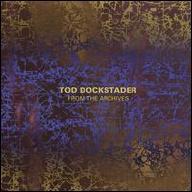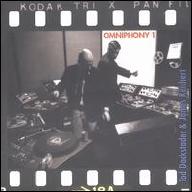In 1955 Dockstader relocated to Hollywood, where he was hired as an apprentice film editor at Terrytoons Animation, working alongside future luminaries such as cartoonist Jules Feiffer and director Ralph Bakshi. He soon graduated to writing and storyboarding his own cartoons, earning renown for his The FreezeYum Story before relocating to New York in 1958, where he landed a job as an assistant recording engineer at Gotham Recording Studios. There Dockstader began collecting interesting sounds, in his off-hours assembling his earliest musique concrète projects. The end result was 1960's Eight Electronic Pieces, his first major work; shortly thereafter Gotham purchased its first stereo Ampex recorder, allowing Dockstader to revise piece No. 8 for his first stereo project, Traveling Music.
On May 20, 1961, New York's WQXR broadcast the world premiere of Traveling Music on a program also featuring Edgard Varèse's Poeme Electronique. That year proved a remarkably productive period in Dockstader's development, as he completed two major works, Luna Park and Apocalypse. (Two Fragments from Apocalypse, also from 1961, consists of a large chunk edited from the latter.) His creations at this time reflect his increasing mastery of the studio and its endless possibilities, making use of techniques including tape-echo antiphony, channel delay, placement, and panning; best labeled as "organized sound," Dockstader's radical construction and manipulation of audio fragments eschewed the harmony and rhythm that typically define music, yet their flow, balance, and spatial dynamics suggested an artistry far beyond the noisy experiments of his peers.
Revolutionary projects like 1962's Drone and 1963's Water Music followed, and by the time Dockstader completed his masterpiece, 1964's 46-minute epic Quatermass, he had accumulated a sound library of about 300,000 feet of tape equaling 125 hours of source material. A year later, however, his career in musique concrète essentially came to a halt with the test-generator piece Four Telemetry Tapes -- soon after, Dockstader left his engineering position at Gotham to work as an audio-visual designer at the Air Canada Pavilion at the 1967 Montreal Expo, where he crafted dozens of soundtracks while shooting thousands of slide photographs as well as a film. Concurrently, he also wrote music and book criticism for Electronic Music Review and Musical Quarterly.
Around this same time, the Owl Records label issued three LPs of Dockstader material that were reviewed favorably in a number of national publications, earning him the widest recognition of his career. The exposure, however, proved fruitless -- without his Gotham job he was no longer able to access the technology necessary to continue his sound experiments, and without the proper academic background he was denied grants and shut out of electronic music facilities, rejected by the Columbia-Princeton Center, among others. The end result was that Dockstader returned full-time to his audio-visual work, in the years to follow writing and producing hundreds of educational filmstrips and videos for schools. Long out of print, his music was finally reissued to great acclaim during the early '80s, becoming a seminal influence on the electronic artists of the following decade. During the early 2000s, Dockstader and David Lee Myers collaborated for the electro-acoustic albums Pond (2004) and Release (2005). Additionally, Dockstader produced the three-volume Aerial series (2005-2006), derived from shortwave radio recordings. On the evening of February 27, 2015, Dockstader died while listening to his music beside documentarian Justin H. Brierley. Dockstader was 82 years old. ~ Jason Ankeny, Rovi


















